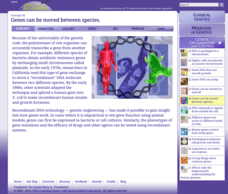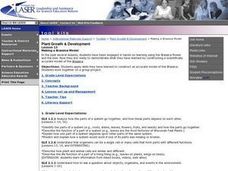Rensselaer Polytechnic Institute
Molecules to the Max!—Teacher's Discovery Guide
Molecules to the Max! refers to a movie released in 2009 about the world of atoms and molecules. A helpful discovery guide provides five posters on science topics typically covered at the middle school level. It also explains the...
California Academy of Science
Composting: A Scientific Investigation: California Academy of Sciences
Garbage, recycle, compost: Does it really matter where we put our trash once we are done? By making detailed observations over seven weeks, kids will see which materials break down naturally to become a healthy part of the soil, and...
Polar Trec
Calorimetry Lab
Young people between the ages of 11–13 need on average about 2,000 calories per day. Within the lab, groups learn about calorimetry and respiration. They explore how it pertains to humans and animals living the Arctic where cold...
Curated OER
LP 6--8: Xenopus laevis (frog) Development for a 7th Grade Audience
Seventh graders view lab stations with Xenopus at different stages of development. They identify the life stage of the sample, as well as the previous and next stages. Students must explain their reason for selecting the specific stage.
Curated OER
Build a Coral Polyp
Students build a coral polyp out of a banana, straw, oyster crackers, sprinkles, and more. For this coral polyp lesson plan, students also list the differences between plants and animals.
Curated OER
Pollination Power
Second graders study and examine the structure of a flower. In this pollination lesson, 2nd graders observe pollinators in the garden and dissect a flower. Students then plant strawberry plants in the garden and observe the process...
Curated OER
Fungi
Lovely pictures help to summarize the different characteristics of fungi in this PowerPoint which covers structure, function and the way that fungi get nutrients. Symbiotic relationships are examined, and some commercial uses are...
Outdoor Learning Center
Outdoor Survival
Which of the following can you survive without for the longest time: water, food, or a positive mental attitude? The answer may surprise you. Guide learners of all ages through games, activities, and discussions about surviving in the...
National Nanotechnology Infrastructure Network
Help or Hype: The Ethics of Bio-Nanotechnology
Ethical concerns are not always black and white. A well-designed lesson presents learners with scenarios for which ethics may come into question. Scholars learn to consider the different sides of a situation and make an unbiased...
Cold Spring Harbor Laboratory
Genes Can Be Moved Between Species
Biotechnology changes lives every day, but how did it all start? Learn about Cohen and Boyer's technique for recombinant DNA and the founding of this new scientific study. Then, scholars use the online interactive to discover how Hanahan...
American Museum of Natural History
Mythic Creatures Challenge
Mythic creatures and where to find them is the subject of an engaging interactive resource. Young anthropologists click on a bright red X on a world map to see an image of and learn the stories of 15 legendary creatures.
American Museum of Natural History
Paleontology Books
A list of 11 books about paleontology offers titles, authors, and a brief description of the tale.
Curated OER
Where Are The Dinosaurs?
Students study what happened to the dinosaurs and possible causes of extinction. In this investigative lesson students create dinosaur eggs.
Curated OER
REPRODUCTION
Students complete a variety of activities to study different concepts in Science. The activities are part of a layered curriculum. This is used to differentiate instruction and give a wide variety of assessment opportunities.
Curated OER
Making a Brassica Model
Middle schoolers apply skills they have learned to construct an accurate model of the Brassica and then work together on a group project. They analyze how the parts of a system go together, and how these parts depend on each other. ...
Curated OER
Paramecium
In this paramecium worksheet, students sharpen their science skills as they color the parts of a paramecium according to the instructions and then respond to 15 analysis questions.
Curated OER
Genetics
Students explain the difference between dominant and recessive genes, identify what causes differences in the traits of parents and their offspring, and explain how sex is determined. They will also improve their reading and...
Curated OER
Biology: Humans as Organisms
Students examine body systems. In this biology lesson, students explore the roles of different body systems and discover the effects of smoking, drugs, alcohol, exercise, and good nutrition on human body systems.
Curated OER
Mass vs. Weight
Students explore physical science by conducting a measurement experiment. In this mass lesson plan, students identify the differences between mass and weight and define a list of other vocabulary terms. Students utilize electronic scales...
Curated OER
Planetary Orbits
Students explore space science by completing a solar system identification worksheet. In this planets instructional activity, students discuss the different planets in our star system and identify their traits. Students complete an...
Curated OER
Recycling Vocabulary Maze
In this recycling vocabulary learning exercise, students find their way through a maze by using clues about recycling and spelling out words. A reference web site is included for additional activities.
Curated OER
Recycling Spelling Activity
In this recycling worksheet, students read definitions of recycling words, then fill in missing letters to complete the matching words. A reference web site is given for additional activities.
Curated OER
Recycling Definitions Activity
In this recycling instructional activity, students choose the correct definition for a set of 15 words related to recycling. A reference web site is included for additional activities.
Curated OER
Recycling- Multiple Choice Words
In this recycling activity, students complete 10 multiple choice questions, choosing the correct recycling related word that fits a given description.

























